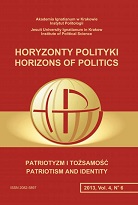„Mała stabilizacja” w organizacjach powiatowych PZPR – na przykładzie Bochni, Brzeska i Chrzanowa
“Small stabilization” in district organizations of the PUWP: the examples of Bochnia, Brzesko and Chrzanow
Author(s): Sebastian DrabikSubject(s): Politics / Political Sciences
Published by: Uniwersytet Ignatianum w Krakowie
Keywords: PUWP; party; District Committee; Voivodship Committee; Brzesko; Bochnia; Brzesko; Chrzanow
Summary/Abstract: The Polish United Workers Party in second half of the twentieth century exercised a dictatorship in Poland. The party controlled all spheres of public life – including those of the political, economic, and judicial. At the local level, the District Committee was an important institution of the PUWP. In the 1960s the Voivodship (regional government) of Cracow contained 17 districts. The article examines three of these: Bochnia, Brzesko and Chrzanow. The text analyzes each one’s land area, population and economic character. The author describes the number of members and candidates of the PUWP, their social structure, education and age. In the districts of Bochnia and Brzesko, the party had a relatively weak influence. There was a strong attachment to tradition, patriotism and the faith of their ancestors. In contrast, Chrzanow contained strong leftist influences before 1939. A large part of the inhabitants were workers in many plants (coal mines, steel mills, power stations). From this area came a number of well-known party activists. Famous political figures from Chrzanow included Franciszek Szlachcic, a member of the Politburo and secretary of the Central Committee of the PUWP, and Stanisław Spyt, president Commission of Party Control and member of the Executive Voivodship Committee in Crakow. Research on the regional structures of the communist party in Poland is an important academic question.
Journal: Horyzonty Polityki
- Issue Year: 4/2013
- Issue No: 06
- Page Range: 115-140
- Page Count: 25
- Language: Polish

